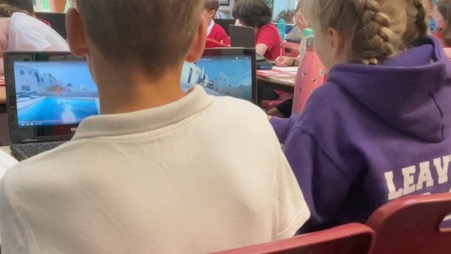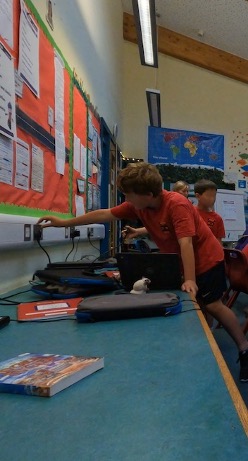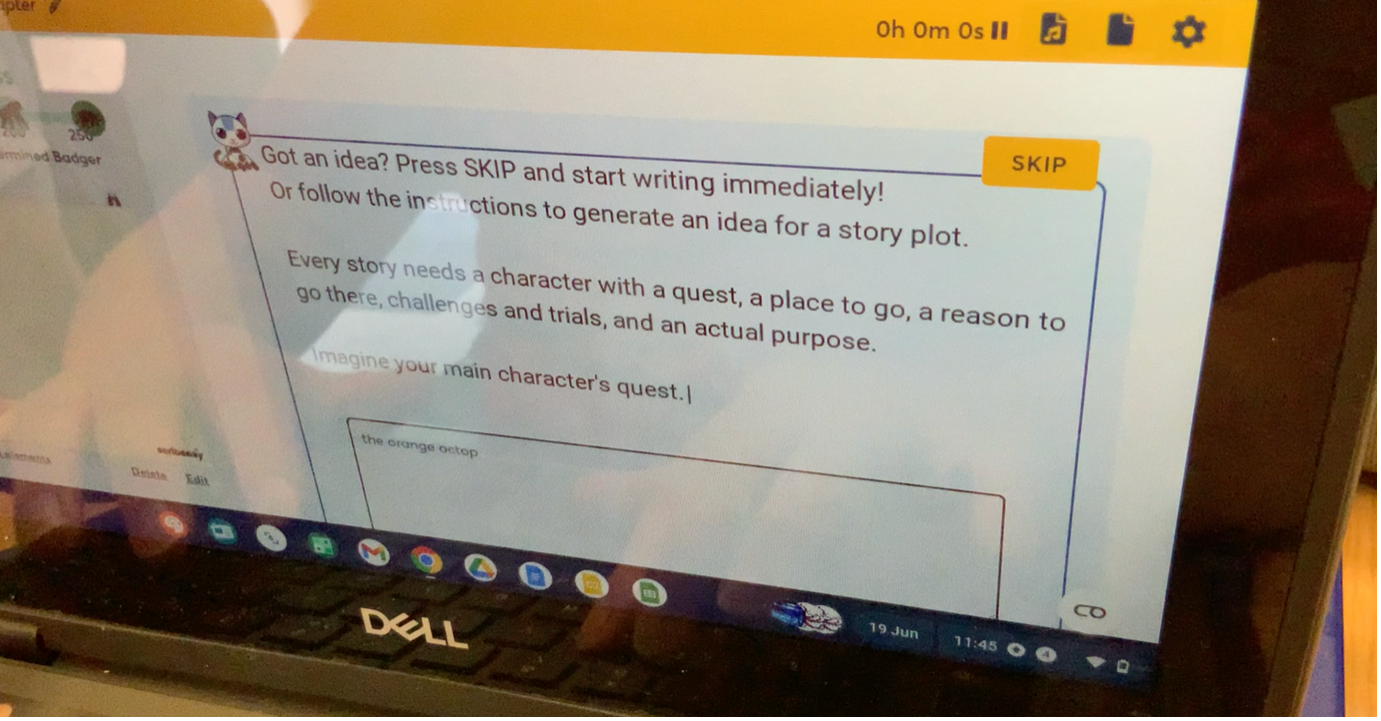Lesson Commentary
Referring to Online film and Padlet to support writing
The teacher asks children to use the planning sheet, which is handed out, to create a concise and clear plan for their stories. The planning sheet encourages children to write keywords and short narrative ideas.
The children all open their Chromebooks, and immediately find the previously created Padlets in front of them. Some begin to talk to the person sitting next to them, while others seemingly work individually. The classroom immediately becomes a hive of activity, with children talking, getting pens, and swiping the screens of their Chromebooks to move between the various Padlets. Quite a few children take the opportunity to get inspiration from re-watching the Oktapodi film in one of the Padlets.
The link to the video can be found in the Padlet and is always visible on two of the three Padlets. When pressing the play-button, the video opens in full screen. The children use the space bar to quickly stop and start the video. They watch short sections (1 or 2 seconds), then pause, and write in their books, which they have directly in front of them.

Pressing the space bar to quickly start-stop the video
The children are sitting close to the screen, and move quickly between the Chromebook screens and their planning sheets. They also flip easily between the film and the Padlet content, which is available as open tabs on their Chromebooks. It is clear that the children are very confident in using the technology, easily switching between the Padlet and the video, and are stopping and starting the video independently. They scroll through the video to find points of interest, and occasionally watch segments in slow-motion or use the freeze-frame function to stop the action and write something in their planner.
The Padlet itself contains characters that convey emotions, which are presented as moving images. Rather than showing a static picture, the children see the various characters changing their face, acting out the emotion. Like the film, the moving images seem to support the children in their thinking about conveying emotions in writing. Combined with their own contributions underneath each picture, the moving images serve to stimulate vocabulary development.
The film and Padlet provides an instantly-available inspiration for their character ideas, and the children seem absorbed in the planning process.
Technologies allow for informal collaboration and fluidity
The writing task itself is complex, as children have to negotiate narrative structure, perspective shifting, writing emotions, and pathetic fallacy, as the characters in the film are non-human. At the beginning of the activity, we see a lot of start-stop writing. Children intently write something, then play a bit of film, then look at each others’ screens to one of the Padlets, stopping and thinking, then write something again. The process of writing also involves physical movement: looking up, looking at planner, using padlet/ not using padlet. One child shifts from the Padlet to the video to the story planner, to writing using a fountain pen. Yet despite the numerous resources, there is a fluidity in the way in which the children use them.
There is also fluidity in the way in which the children work together. They often share screens in a pair, while writing individually in their planners. There is a lot of talk between children about their story-plans throughout the activity, and the classroom feels like a writing community, with children being involved in each other’s writing tasks and interested in each other’s ideas.
The atmosphere in the class seems warm and companionable, yet productive. The children are completely involved in the activity and in each other’s ideas and work. They are gently chatting and giggling at suggestions, and some are singing along with soundtrack of the film. They are sharing ideas - “let me see” and are keen to hear others’ ideas.
Independent use of digital tools
A table is set up alongside a wall in the class, that contains a number of laptop bags with Chromebooks on chargers. Children walk over independently to charge their Chromebooks, if it is running low on battery, or if they are not using their Chromebooks for a while. As with the collaboration, there is a sense of fluidity that underpins this. The children have responsibility for their own Chromebooks, carry it around the class and charge when necessary. While the table looks messy, there is a sense of familiarity; no-one looks up when a child moves to charge their laptops and one child even temporarily sits on the table with his Chromebook, to check its charge, before storing the charger and cable in his laptop bag.

Independent charging of Chromebooks
The familiarity of the children with the digital tools, mean they can fully focus on their stories. Despite active use of the Padlets and the video, they are not distracted by the technologies, but use them to propel their story planning. Before leaving the classroom to go on their break, the children independently pack their Chromebooks and chargers into their laptop bags and move them out of the way.
Story planning with ScribEasy for children with SEND
While most children in the class use the Padlets and their planner to plan their stories, there are three children with SEND who are using ScribEasy to plan their story, supported by a TA. They use the same characters as the rest of the class, and base their narrative stories on the same film. They also have access to the same Padlets, although they do not use their own Chromebooks, and instead use school-owned laptops.
They do not move back and forth as much between the Padlets and their planner, but instead rely more on the use of prompts in ScribEasy to propel their planning. Interestingly, the TA supporting these children does remind them to use their Padlets, but there seems to be less need to refer to these. Instead, children type their responses in the various boxes when prompted directly in ScribEasy.

Typing up their plan in ScribEasy, following prompts by the software
The software reads back whatever the child has written, and the children often use this feature. They thus type in a sentence, and ask the software to read back to them what they have written. The children are excited to use the new resource and happily explore the various features in the software. The teacher occasionally comes over to watch what they are doing, but by and large, they are working collaboratively, yet independently. The TA is at hand for any immediate support needed, but as she is new to the software too, there is a sense of shared exploration, while figuring out how everything works. Despite the novelty, the children are quickly beginning their planning activity, and they seem motivated by the prompts provided by the software.
Sharing writing in a plenary
At the end of the activity, the teacher invites the children to share what they have written with the rest of the class. Children are keen to share their ideas, and there are multiple raised hands throughout the plenary. They begin with their plan for writing ‘from the driver’s point of view’. One of the children who worked with ScribeEasy offers to read their idea. The teacher later mentions that this does not happen very often for writing tasks, as these children often struggle to participate.
Children watch one-another when they read out their sentences, and there is a clear sense of support for one-another's writing. A girl reads out her sentence, and several others nod and audibly respond with ‘nice’. Even though children write individual stories, there is a sense of community.
The teacher points back at the IWB, to reinforce the learning objectives. He reminds the children to re-watch the opening scene carefully, and indicates that they are going to talk about DADWAVERS after the break, which he points out on a wall display.
This lesson finishes with a final couple of minutes in which the children finish their plans. Children are asked to glue their worksheets into their workbooks, indicating a need to evidence the development of writing. This can also serve as another resource in the act of narrative writing, along with the resources already available (digital and non-digital).
Observations about enjoyment and engagement
Children referred to Padlet throughout the activity, often switching between the various Padlets available and between the Padlet resources and their pen and paper task. They watched and re-watched the video and scrolled through the comments on the Padlets, occasionally pointing these out to their neighbour. The Padlets clearly served as a driver for sustained planning activity.
